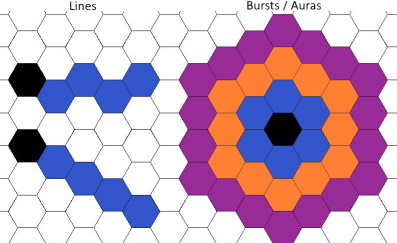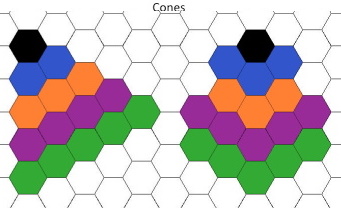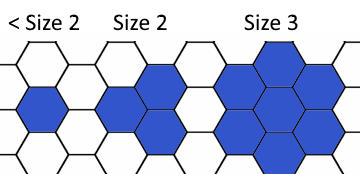

|
|
Event Schedule |
The Battlefield
There are many ways to move around the world and navigate obstacles. All rolls defined on this page are Mobility rolls.
Grid
Conflict is represented on a hex grid. Edge-to-edge of each hex represents 5 feet of space. Place a representation of each character on the grid to track the position of characters in relation to each other.
Shapes
Many effects take form in a given shape. This illustrates how to form those shapes on the hex grid. The black space is the origin space of the effect. Cones that start facing an edge expand outwards only every other space.


Physical Size

These dimensions and weights are the common amounts for creatures and objects of a given size. See Playable Species for how size affects a creature.
Area and Targeting
An effect's area defines where it takes place. You may reduce the Area value of an ability as you Manifest it by any amount. When using an effect that attacks multiple targets, roll once for your attack and roll damage separately for each target. Each type of area has a Tier.
Self (Tier 0)
The effect only applies to you. Effects that do not specify an area are Self.
Target (Tier 1)
The origin space can be anywhere in your Reach. Count the origin space and then contiguous spaces in any direction until you have counted spaces equal to the range. Affects a single specified target your senses allow you to target in any space you can count in this way. Choose your target as part of declaring an action that has a target.
Line (Tier 2) and Cone (Tier 3)
Create a Line or Cone shape with an origin space anywhere in your Reach. It continues in a direction away from you for a number of spaces equal to the value. It affects all creatures and unattended objects in the area.
Burst (Tier 4) and Aura (Tier 5)
The origin space is all spaces of a creature or object that is the source of the effect. Create a Burst / Aura shape that continues away from the origin space for a number of spaces equal to the value. Value 0 affects only the origin space. It affects all creatures and unattended objects in the area. You can choose to be unaffected by a Burst you Manifest if you are in the origin space. If the source of an Aura moves, the Aura moves with it.
If the effects is physical, targets in the area above size 1 are affected a number of times equal to their size. If parts of the creature are not in the area, only use the parts that are to determine its size.
Crowded
When multiple creatures and objects share a space, they hamper each other and count as adjacent. Ignore creatures and objects 4 or more sizes smaller than you. Crowded causes Tier 1 Encumbered, increases Movement costs by 1, and cannot exceed Tier 3.
For each other size 0 or larger creature or object in a space you occupy, have Tier 1 Crowded. Each two creatures or objects of the same size count as 1 size larger. A creature that occupies more than 1 space counts as 1 size 0 creature in each space they occupy.
A space containing 4 size 0 creatures is fully occupied. You cannot move into an occupied space if you would cause it to be more than fully occupied. While adjacent to a space that is fully occupied, you can target subjects in the space as if you can Reach them even if you normally could not.
Concealment
Poor lighting, weather conditions, or magic can create Concealment, Tier 1 through 12. If any space you or a target are in or that is between you and a target creates Concealment, that target has Concealment from you. If you are adjacent to a target, reduce the Concealment by 3 Tiers. For each Tier of Concealment your target has, have -1 on Awareness rolls affected by the type of Concealment. Concealment against the senses you are using to choose a target also causes half this penalty on targeted attack rolls against them.
Movement
Each creature begins with a Movement Pool of 5. Before moving, you may reduce you Movement Pool by any amount for 1 round. During your turn, you can move 1 space by paying 1 Movement. Effects that include movement as part of their effect allow you to move at that time, though you must still pay the Movement cost. At the start of your turn, remove all Movement Pips.
If you must roll to determine if you can move, such as to Swim, Balance, or Squeeze, roll once when the event occurs. That roll applies until your next turn starts unless the condition changes, such as moving from ice to oil.
After moving, you are considered moving until you end your turn without moving any spaces that turn or pay 1 Movement to stop. Movement is not an action and creates a Magnitude 2 + your size sound.
Amble (No Action)
While not already using Amble, increase Movement costs to move by 1 to reduce the Magnitude of sound you make by 1 for 1 round. Movement this turn does not count towards Overexertion.
Crouching
While Crouching, have Tier 1 Encumbered. Increase Movement costs to move by 1. Standing costs 1 Movement.
Prone
When you become Prone, fall. While Prone, have Tier 2 Encumbered and increase Load by 1. Increase Movement costs to move by 2. Standing costs 2 Movement and Crouching costs 1 Movement.
Jump (Movement - Athletics)
Jump determines if you can be off the ground during your movement. As you would move, you may use either long jump or high jump and declare what space you will attempt to Jump to. On success, you remain off the ground during your movement there. On failure, your jump ends at the allowed distance.
You can long jump up to a number of feet equal to your result. If you long jump without first moving at least 2 spaces to gain momentum, the distance is halved. Otherwise, gain a bonus on your roll equal to the amount your Movement Pool exceeds 5. You can high jump to raise your center of mass up to 4 inches x your result. Take a penalty on Jump rolls equal to your sizes smaller than 0.
While off the ground, you have Tier 2 Encumbered. If you Jump to a space of increased elevation, you may choose not to fall until the start of your next turn, though then may not move again until you land. If you run out of Movement before reaching your target space, you remain in the air and continue moving when you gain additional Movement. If you are in the air and your Movement Pool becomes 0, fall.
Climb (Movement - Athletics)
When faced with a specific area that is angled over 45 degrees, roll Climb to move. This requires 2 Free Limbs and is DL 6. For each additional Free Limb, hoof, or foot you use, gain +1 on your roll. If you fail by 4 or more, fall. While Climbing, increases Movement costs by 1 and have Tier 2 Encumbered.
Suffer penalties on your roll based on the surface. Having only small handholds causes -1 on your roll. Having no handhold, a slippery surface, a surface steeper than 60 degrees, and a surface steeper than 90 degrees each causes -2 on your roll.
Movement Types
Each creature begins with Land as a Primary Movement type and Swim as a Secondary Movement type. You can pay 1 Movement to move 1 space with a Primary Movement. Movement with a Secondary Movement type increases the cost by 1 and you must roll for Overexertion after each 10 minutes.
Swim
While Swimming, you cannot run, be Crouched, or be Prone. To move using Swim, roll Athletics, DL 3.
Burrow
You can move through loose ground that falls closed behind you. Packed ground increases the cost by 1. The Soulweaver determines if ground is able to be burrowed through.
Flight
You can increase or decrease your elevation by moving. When you use Movement to increase your elevation, increase the cost by 1. If you carry more than your Bulk Limit, you cannot increase your elevation, and you lose 1 elevation at the end of your turn. If you carry more than double your Bulk Limit, you fall. While flying, you cannot be Prone.
Flight with Wings
You can use 2 wings to fly. If you suffer Grit Injury, roll Athletics to not fall, DL equal to double Injury. Count as 2 sizes larger to determine Crowded, sound you make from movement, and when you are attacked with Martial or Nimble.
Falling
If you are not flying and do not have a surface to stand on, begin falling. While falling, you are considered moving. When you begin to fall, fall 5 spaces immediately. At the beginning of your first turn while falling, fall 80 spaces, and fall 175 spaces on each other turn. You may take actions at any point during the fall.
If you are physically connected to another creature, such as from Held, you also fall any time they do. If creatures would fall a different distance at the start of their turn, fall the furthest distance of any connected creature. Do not fall at the start of your turn during a round you have already fallen at the start of a turn.
Prevent Fall (Reaction - Athletics)
Before falling spaces, if you can fly, pay 1 Movement to reduce the spaces you fall on this and following turns by the result. If this reduces the spaces to 0, you stop falling and begin flying.
While falling, if there is a surface in Reach, roll Climb. If you succeed to Climb that surface, stop falling and any Serious Injury caused from Collision only affects the limbs used.
Colliding
Collision may occur and deal damage while you are moving and your path is blocked. Each creature and object in a Collision takes Bashing damage, and if multiple creatures or objects were moving in opposing directions before Collision, the damage from each is added to each other. Armor does not reduce damage from Collision and each part of armor also takes half the damage you take. Injury from Collision causes Balance, DL increased by the Injury. Several factors determine how much damage is dealt by Collision.
When a creature or object enters a space other than through its own movement, it counts as Attacking Blind against that space using a weapon 4 sizes larger than the moving creature or object. When this attack succeeds or there is no path of travel possible in the space, collision occurs and the creature or object stops moving.
Soften Collision (Reaction - Nimble)
Knowing how to fall correctly can help keep you safe when you have found yourself without ground beneath your feet. As you would take damage from Colliding, reduce the damage by 1 + 1 for each 3 you exceed the DL and fall Prone, DL 6.
© Grinning Demon Games ~ admin@SoulshardsRPG.com
Yitzi Santer: Creator | Clinton Menezes: Lead Developer | Travis Almon: Lead Writer Merch Store ~ The Team ~ Our Friends |